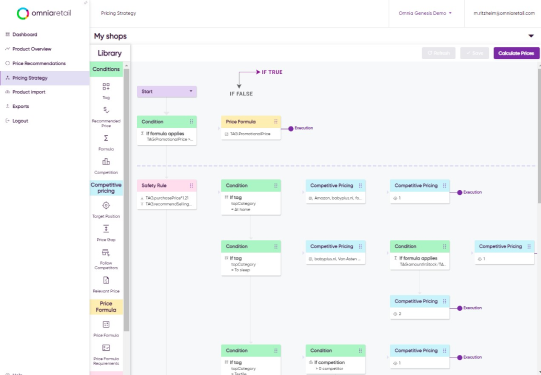Direct-to-consumer (DTC) brands have revolutionized retail by offering unparalleled control over customer experience, pricing, and brand narrative. However, for established brands with existing wholesale and retail networks, the transition to DTC presents both tremendous opportunities and significant risks. The key challenge: how do you unlock DTC profitability without triggering price erosion or damaging crucial retailer relationships?
This comprehensive roadmap explores the strategic framework for navigating DTC transitions successfully, based on real-world insights from enterprise brands and proven methodologies for preventing channel conflict while building sustainable, profitable DTC businesses.
Introduction: The DTC Opportunity and Strategic Dilemma
Digitalization has revolutionized how brands connect with consumers. DTC channels allow for full control over the customer experience, product presentation, and pricing strategy. For newer, digitally native brands, this is a natural evolution. But for established brands, particularly those born in retail or wholesale environments, the move to DTC can present strategic and operational challenges.
The core issue lies in balancing innovation and tradition. Retail partners have often contributed to the brand's presence and revenue, and risking those relationships in pursuit of DTC gains can backfire. Brands need to ask: Is there a way to pursue DTC without triggering channel conflict or eroding trust with retail partners?
The short answer: Yes, if done with strategic care.-1.png?width=650&height=406&name=Untitled%20design%20(16)-1.png)
Digitalization has transformed how brands engage with consumers, especially through direct-to-consumer (DTC) channels. DTC enables brands to fully control customer experience, product presentation, and pricing strategy. Digitally native brands adopt DTC naturally, but legacy brands face strategic and operational hurdles.
The main challenge is balancing DTC growth with maintaining strong retail and wholesale partnerships. With careful strategy, brands can expand into DTC without causing channel conflict or damaging partner trust.
The Mechanics and Impacts of Price Erosion
How Price Erosion Starts
Price erosion is most prevalent in brands with large, uncontrolled distribution networks. These networks often span multiple countries and regions, where retailers make independent pricing decisions. This decentralized model creates vulnerabilities.
When a few retailers in a region decide to aggressively lower prices, it triggers a domino effect. Competing retailers feel compelled to match or beat those prices, leading to a race to the bottom.
.png?width=645&height=403&name=Untitled%20design%20(17).png)
Consequences for Retailers
Retailers bear the brunt of price erosion. Their profit margins shrink, which weakens their incentive to promote or prioritize a brand's products. If this pattern continues over several seasons, retailers may drop the brand entirely in favor of others that offer more stable pricing and healthier margins. Over time, this undermines the brand's presence in key markets and jeopardizes long-standing retail relationships.
The Brand Perspective
For brands, the impact is equally severe. Adidas and GoPro are both examples of brands affected by price erosion due to broad, decentralized distribution networks. Retailers often undercut each other on popular Adidas sneakers or older GoPro models, triggering a race to the bottom. This erodes margins, weakens retailer commitment, and ultimately damages the brand's premium positioning.
.png?width=758&height=303&name=Untitled%20design%20(20).png)
When retailers face margin pressure, they typically respond by demanding lower wholesale prices from the brand, which ultimately puts strain on the brand's own profitability. Aside from lost margin, price erosion can damage the brand's perceived value. It becomes harder to justify premium pricing if consumers become conditioned to frequent discounts. The brand's strategic positioning in the market suffers, and future DTC efforts may be undermined by a customer base expecting perpetual sales.
Exploring the Benefits of DTC
Direct-to-consumer (DTC) gives brands greater control, higher margins, and direct access to their customers. By cutting out intermediaries, brands can optimize the customer experience, launch innovations quickly, and own valuable first-party data. DTC also opens the door to stronger loyalty and deeper customer relationships.
Key Advantages of the DTC Model
The direct-to-consumer model creates opportunities across multiple areas. Let's break them down:
Margin Expansion Through Direct Sales
Without intermediaries, brands keep a bigger share of each transaction, which is crucial in competitive markets with wholesale discounts that cut into profits.
Control Over Product and Brand Experience
DTC gives you full control over visuals, packaging, dynamic pricing, and after-sales, ensuring consistency, better customer experience, and fewer channel conflicts over promotional timing.
Product Innovation and Limited Editions
The DTC model supports rapid experimentation. Brands can launch exclusive colors, sizes, or features online and gauge interest in real time. Smaller production runs become viable, giving brands more flexibility to innovate.
Data Ownership and Customer Insight
DTC transactions give brands valuable first-party data for understanding behavior, segmenting audiences, and tailoring marketing. This includes insights into who buys, what they buy, when, and how often.
Building Loyalty and Community
Owning the customer relationship means brands can build loyalty through tailored experiences, memberships, and rewards. Loyalty programs and email marketing create opportunities for repeat sales and deeper brand engagement.
Managing Channel Conflict: A Brand's Biggest Fear
Balancing DTC and Retailers
For many brands, retailers still drive over 90% of sales, making DTC transitions sensitive. Retailers may feel threatened by lower DTC pricing or exclusive launches, especially if communication is lacking or the brand appears to undercut partners.
Internal resistance from brand executives often stems from fears that DTC may cannibalize retail revenue, particularly when wholesale accounts represent the vast majority of current business.
Mitigation Strategies
Maintain open communication with retail partners to clarify DTC strategies and pricing. Clearly explain pricing logic and indicate which products will remain retail-exclusive to emphasize that DTC is complementary rather than competitive.
With pricing software like Omnia, automated pricing is not a black box: Retailers can see exactly how and why a price is calculated, which helps eliminate confusion and strengthen collaboration.
Tactical Ways to Avoid Conflict
To avoid channel conflict, brands can differentiate product assortments, maintain pricing parity, and run joint promotions with retail partners. Sharing DTC data can also support wholesale planning and strengthen collaboration.
- Assortment Differentiation: Keep products or bundles exclusive to either DTC or retail.
- Pricing Parity: Avoid undercutting retail prices online.
- Data Sharing: Use DTC insights to inform wholesale planning and inventory optimization.
- Joint Promotions: Offer coordinated campaigns where both retail and DTC benefit.
Strategic Framework: How Brands Can Improve Profitability
Phase 1: Optimize the Distribution Network
Start with a clear view of all sales channels. Prioritize partners who invest in your brand and deliver a consistent customer experience. Use objective criteria—like service levels and brand alignment—to guide more selective distribution. With wholesale, pricing control is limited, so market monitoring is essential.
Phase 2: Establish DTC Infrastructure
Build a strong ecommerce foundation with fast fulfillment, branded packaging, and responsive customer service. Unlike B2B, DTC demands operational precision and direct customer engagement. Track customer behavior and product performance to guide decisions.
Phase 3: Align DTC Pricing with the Market
Avoid undercutting retailers by applying a logic-based, transparent DTC pricing strategy. Automation helps maintain consistency, build trust, and prevent ad hoc price changes that erode confidence.
Phase 4: Iterate Using Feedback Loops
Use data from both DTC and retail to refine pricing and assortments. Identify top-performing DTC products and feed those insights back into your retail strategy.
.png?width=5760&height=3240&name=Blog%20covers%20(3).png)
For brands willing to communicate openly, invest in the right systems, and align on pricing logic, the DTC shift is not a threat—it's a scalable opportunity.
Traditional Retail vs. DTC vs. Hybrid Approach
| Aspect | Traditional Retail | DTC | Hybrid (Omnichannel) |
|---|---|---|---|
| Margin Control | Low | High | Moderate–High |
| Data Ownership | Minimal | Full | Partial, but growing |
| Pricing Flexibility | Limited | High | Moderate (with tooling) |
| Brand Experience Control | Low | Full | Shared |
| Speed of Innovation | Slower | Faster | Context-dependent |
Key Takeaways
- A selective distribution network improves long-term brand value and pricing control.
- Strong DTC infrastructure enables experimentation, customer insight, and margin gains.
- Transparent, logic-based pricing helps maintain trust with retail partners.
- Continuous feedback from DTC and retail channels supports smarter, data-driven decisions.
Why the Fear is Overstated—and How to Move Forward
Understanding the Root Cause of This Fear
For brands with well-established wholesale channels, transitioning into DTC brings inherent tension. Executives often see it as a threat to their existing cash flow, particularly when traditional retail accounts for up to 90% of revenue. These concerns are understandable, but manageable with the right approach.
Rather than viewing DTC and retail as competing channels, leading brands recognize their complementary strengths:
- Retail delivers scale, reach, and steady volume
- DTC offers control, agility, direct data, and higher margins
- Together, they create a balanced go-to-market strategy that builds long-term brand value
A strong DTC presence can also benefit retail partners. It sets a clear benchmark for how the brand should be priced, merchandised, and experienced, helping retailers elevate their own performance.
Embracing a Complementary Model
Brands that embrace the complementary relationship between DTC (Direct-to-Consumer) and retail channels can innovate and grow without disrupting existing revenue. Clear boundaries allow DTC to focus on exclusive products, while retail serves as an experiential touchpoint. Utilizing DTC insights strengthens retail strategies, such as routing popular SKUs and guiding pricing through A/B testing, enhancing the overall commercial engine.
Brands that embrace the complementary relationship between DTC (Direct-to-Consumer) and retail channels can innovate and grow without disrupting existing revenue.
Internal Culture Shift
Implementing a DTC strategy also requires a cultural shift, breaking down silos between teams and fostering collaboration in sales, marketing, and product development. Education and communication of the dual-channel vision, along with demonstrating quick wins, are crucial for gaining internal support.
The Value of a Measured Approach
Brands don't need to dive into DTC with a global rollout. A smarter path is to start small, launching in one market or product line, then iterate. This allows the brand to:
- Test logistics and fulfillment
- Gather customer feedback and improve UX
- Monitor channel conflict in a controlled way
Once a stable model is in place, it can be scaled across markets or categories. Proving success on a smaller scale builds trust and confidence among internal and external stakeholders.
.png?width=748&height=299&name=Untitled%20design%20(21).png)
Conclusion: A Smarter Path to Profitability
Harmonizing DTC and Retail for Long-Term Growth
A DTC strategy doesn't need to disrupt retail partnerships. When implemented thoughtfully, it becomes a valuable complement—creating a hybrid model that's stronger than either channel alone.
Retail partners remain key for reach, service, and physical presence. DTC adds value through direct customer relationships, faster feedback loops, and innovation. When aligned in messaging, pricing, and data, both channels reinforce each other and build a more resilient commercial engine.
The Role of Technology and Data
Technology makes this alignment possible. Dynamic pricing tools, unified data platforms, and real-time analytics help brands react with precision, monitoring price shifts, optimizing margins, and staying consistent across markets.
CRM and loyalty tools also ensure seamless customer experiences, whether in-store or online, supporting personalization at every touchpoint.
Key Takeaways
- DTC can complement—not compete with—retail when integrated thoughtfully into a hybrid commerce strategy.
- Retail remains vital for reach and physical presence, while DTC offers direct customer relationships and rapid feedback loops.
- Aligning messaging, pricing, and customer data across channels builds a more resilient and modern commercial model.
- Technology like dynamic pricing, centralized data platforms, and real-time analytics ensures agility and coordination.
- Loyalty tools and CRM systems enable seamless, personalized experiences across both retail and DTC channels.
Partnering with Omnia
At Omnia Retail, we specialize in helping brands navigate the complex landscape of pricing, distribution, and channel strategy. Our solutions empower brands to take control of their pricing architecture, manage relationships with retail partners, and unlock the full value of DTC.
We believe in sustainable commerce built on collaboration, transparency, and smart automation. Whether you're building a selective distribution network, launching a DTC pilot, or harmonizing your global pricing strategy, Omnia is your trusted pricing partner.
Frequently Asked Questions
Can we launch a DTC channel without damaging our retail relationships?
Yes. With clear communication, pricing alignment, and differentiated assortments, brands can build a DTC strategy that complements, rather than competes with, retail partners.
How does Omnia help prevent price erosion across channels?
Omnia's pricing software monitors and manages pricing across all regions and channels, detecting early signs of erosion and allowing brands to enforce pricing consistency through smart automation.
What are the key benefits of adopting a DTC model?
DTC enables higher margins, direct customer relationships, better brand control, faster product innovation, and ownership of valuable first-party data.
How can we minimize internal resistance to DTC within our brand?
Start with pilot programs, share measurable wins, and align incentives across retail and DTC teams. Omnia supports this with tools that provide shared visibility into performance and pricing.
Do we need to fully commit to DTC right away?
No. A phased rollout, starting with select products, regions, or customer segments lets you test logistics, gauge demand, and manage risks before scaling up. Omnia helps manage this process with precision.
Read More About DTC Strategy and Pricing:
- How to Set Up a Request for Proposal (RFP) for Dynamic Pricing Software
- What are the best pricing strategies?: 17 proven strategies for retailers and brands.
- The Ultimate Guide to Dynamic Pricing
- What is Price Monitoring?: Everything you need to know about competitive price tracking.
- What is Value-Based Pricing?: How price and perceived value work together.
- What is Cost-Plus Pricing?: When simplicity beats complexity.
- What is Price Skimming?: Capture early-adopter value responsibly.
- What is MAP Pricing?: Why MAP compliance matters to brands.
.png?width=1500&name=Untitled%20design%20(21).png)


.png?height=766&name=Untitled%20design%20(21).png)

